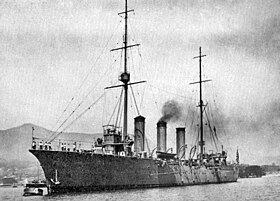Tone (ship, 1907)
|
|
|
|---|---|

|
|
| Overview | |
| Type | Protected cruiser |
| Shipyard |
Sasebo kaigun kōshō |
| Order | 1903 |
| Keel laying | November 27, 1905 |
| Launch | October 24, 1907 |
| Namesake | River Tone |
| Commissioning | May 15, 1910 |
| Decommissioning | April 1, 1931 |
| Whereabouts | Sunk as a target ship in April 1933 |
| Technical specifications | |
| displacement | |
| length |
L pp = 109.7 m |
| width |
14.3 m |
| Draft |
5.12 m |
| crew |
392-401 men |
| drive |
|
| speed |
Construction: 23 kn |
| Range |
7400 nm at 10 kn |
| Armament |
Guns (from Elswick ):
|
| Armor |
Deck: 38 - 52 mm |
| stock |
900 ts coal |
The Tone ( Japanese 利 根 ) from 1907 was a protected cruiser of the Imperial Japanese Navy . It was named after the river Tone in the Kantō plain .
Construction and data
The ship was ordered as a so-called "cruiser 2nd class" under the 3rd Fleet Act of 1903. Parliament refused to finance a proposed sister ship . Construction on the State Shipyard of Sasebo ( 佐世保 海軍 工廠 , Sasebo kaigun kōshō , "Naval Arsenal Sasebo") began on November 27, 1905. Although the ship was launched on October 24, 1907, the ship was not finished until May 15, 1910. Externally, the cruiser was conspicuous with its very sharp clipper bow and high freeboard and was considered to be particularly elegant in terms of its lines.
The length between the perpendiculars was 109.70 m, in the waterline 113.80 m, with a width of 14.30 m and a normal draft of 5.12 m. The water displacement is specified with 3760 ts standard and 4900 ts maximum. It was driven by two vertical 4-cylinder triple expansion machines from Mitsubishi with 16 Miyabara boilers on two screws, with a maximum speed of 23 knots at 15,000 PSi . With 15,215 PSi and 23.37 knots, the planned values on the test drive (with 4103 ts) were slightly exceeded. The boilers could operate in mixed operation, in addition to 900 tons of coal (maximum, normal supply: 300 tons) there were also 125 tons of oil on board, for a sea endurance of 7400 nm at 10 kn. The crew was planned to be 370 and later actually 392–401 men.
Armament and length of service
The armament consisted of two 15.2 cm L / 45 guns behind shields (one each on the forecastle and bulwark ) and twelve 12 cm L / 45 guns (on both sides of the bridge and in a row to the side of the superstructure). However, the foremost of the two-sided 12 cm guns next to the superstructure, which were very cramped with a small field of fire, were quickly removed again without replacement, so that the ship remained armed with ten of these guns. The artillery was supplemented by three permanently installed surface torpedo tubes with a caliber of 45.7 cm. A few smaller guns were also available, after the First World War two 3-inch anti-aircraft guns were added on either side of the first funnel. The armor was made of Krupp steel with a thickness of 38-52-76 mm for the deck and 102 mm for the command tower. There was no side armor.
The cruiser completed its service without major incidents until April 1, 1931 and was then used as the test ship "Haikan No. 2" ( 廃 艦 第 2 号 , "decommissioned warship No. 2"), where it was used as a training target for aircraft served. The ship was sunk in April 1933 off Amami-Ōshima .
gallery
Remarks
- ↑ L pp = length between perpendiculars or length between perpendiculars: distance between the axis of the rudder stock and the trailing edge of the leading edge in the construction waterline.
- ↑ The information on fuel stocks in the literature varies greatly; the aforementioned values are taken from the standard work of the naval designer Kaigun-Shusa (frigate captain) Fukui Shizuo (see individual records ), p. 453.
literature
- Fukui Shizuo: Japanese Naval Vessels Illustrated 1869-1945, Vol.2: Cruisers, Corvettes and Sloops . KK orderers, Tokyo 1980.
- Kizu Tohru: Japanese Cruisers. (Ships of the World Vol. 441), Kaijinsha Co., Tokyo 1991.
- Jentschura, Jung, Mickel: Warships of the Imperial Japanese Navy, 1869-1945 . Arms and Armor Press, London 1977, ISBN 0-85368-151-1 .
- Anthony Watts, Brian Gordon: The Imperial Japanese Navy. MacDonald & Co., London 1971, ISBN 0-356-03045-8 .
Web links
Individual evidence
- ↑ Fukui Shizuo: Japanese Naval Vessels Illustrated 1869-1945, Vol.2: Cruisers, Corvettes and Sloops , p. 453


